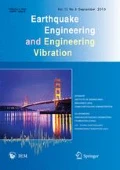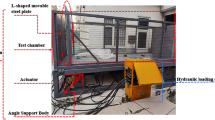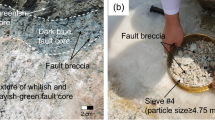Abstract
Severe faults have caused many earthquakes around the world throughout history. More recently, earthquakes have occurred in Taiwan, China (Chi-Chi fault), and elsewhere, causing loss of lives and destroying many buildings and structures. These tectonic movements have gained attention from engineers, and in the past 15 years, the focus has been on faulting mechanisms. In this study, a physical model (1 g) was fabricated and used to evaluate the impact of a reverse fault in a field with a tunnel. In the 1 g model, researchers installed additional gauges on the tunnel, so that all the displacements could be adjusted, and all the responses could be monitored during faulting. An experimental study of various soil properties (cohesion and friction angles) in reverse faults on the tunnel lining were carried out and are described herein. A comparison of results for different levels of soil cohesion revealed that it can dramatically reduce the displacement by as much as 40%, and that friction angles of 27° can record approximately 60% more displacements than at 37°. Furthermore, a comparison of fault angles of 30° and 60° indicates that the displacements can be different by more than 43% in cohesionless soil and about 64% for a friction angle of 27°.
Similar content being viewed by others
References
Alshameri B, Bakar I, Madun A, Abdeldjouad L and Dahlan SH (2016), “Effect of Coarse Materials Percentage in the Shear Strength,” IOP Conference Series: Materials Science and Engineering, 136(1). https://doi.org/10.1088/1757-899X/136/1/012017
Anastasopoulos I, Callerio A, Bransby MF, Davies MCR, El Nahas A, Faccioli E and Rossignol E (2008a), “Numerical Analyses of Fault-Foundation Interaction,” Bulletin of Earthquake Engineering, 6(4): 645–675. https://doi.org/10.1007/s10518-008-9078-1
Anastasopoulos I, Gerolymos N, Gazetas G and Bransby MF (2008b), “Simplified Approach for Design of Raft Foundations Against Fault Rupture. Part I: Free-Field,” Earthquake Engineering and Engineering Vibration, 7(2): 147–163. https://doi.org/10.1007/s11803-008-0835-6
Anastasopoulos I, Gazetas G, Asce M, Bransby MF, Davies MCR and El Nahas A (2007), “Fault Rupture Propagation Through Sand: Finite-Element Analysis and Validation through Centrifuge Experiments,” Journal of Geotechnical and Geoenvironmental Engineering, (August), 943–958.
Anastasopoulos I and Gazetas G (2010), “Analysis of Cut-and-Cover Tunnels Against Large Tectonic Deformation,” Bulletin of Earthquake Engineering, 8(2): 283–307. https://doi.org/10.1007/s10518-009-9135-4
Anastasopoulos I, Gerolymos N, Drosos V, Georgarakos T, Kourkoulis R and Gazetas G (2008c), “Behaviour of Deep Immersed Tunnel Under Combined Normal Fault Rupture Deformation and Subsequent Seismic Shaking,” Bulletin of Earthquake Engineering, 6(2): 213–239. https://doi.org/10.1007/s10518-007-9055-0
Baziar MH, Nabizadeh A, Jung Lee C and Yi Hung W (2014), “Centrifuge Modeling of Interaction Between Reverse Faulting and Tunnel,” Soil Dynamics and Earthquake Engineering, 65: 151–164. https://doi.org/10.1016/j.soildyn.2014.04.008
Bray JD, Seed RB, Cluff LS and Seed HB (1990), “Earthquake Fault Rupture Propagation Through Soil,” Journal of Geotechnical Engineering, 16(2): 543–561. https://doi.org/10.2118/72060-PA
Cai QP, Hu P, Laak PV, Ng CWW, and Chiu ACF (2010a), “Investigation of Boundary Conditions for Simulating Normal Fault Propagation in Centrifuge,” The 4th International Conference on Geotechnical Engineering and Soil Mechanics, 614: 1–8.
Cai QP, Hu P, Van Laak P, Ng CWW and Chiu ACF (2010b), “Investigation of Boundary Conditions for Simulating Normal Fault Propagation in Centrifuge,” Int. Conf. on Geot. Engg., 614: 1–8.
Cole D and Lade PV (1984), “Influence Zones in Alluvium over Dip-Slip Faults,” Journal of Geotechnical Engineering, 110(5): 599–615. https://doi.org/10.1061/(ASCE)0733-9410(1984)110:5(599)
Dönmez C and Pujol S (2005), “Spatial Distribution of Damage Caused by the 1999 Earthquakes in Turkey,” Earthquake Spectra, 21(1): 53–69. https://doi.org/10.1193/1.1850527
Fadaee M, Jafari MK, Kamalian M, Shafiee A and Moosavi SM (2013), “Feasibility Study of Fault Rupture Deviation by Slurry Wall,” International Journal of Civil Engineering, 11(2B): 90–99.
Gazetas G and Anastasopoulos I (2003), Interaction of Foundations with a Rupturing Fault: Case Histories from Gölcük 1999, National Technical University of Athens, Athens, Greece.
Gazetas G, Anastasopoulos I and Apostolou M (2007), “Chapter 9 Shallow and Deep Foundations under Fault Rupture or Strong Seismic Shaking,” Earthquake, 185–215.
Hashemi M, Alesheikh AA and Zolfaghari MR (2017), “A GIS-Based Time-Dependent Seismic Source Modeling of Northern Iran,” Earthquake Engineering and Engineering Vibration, 16(1): 33–45. https://doi.org/10.1007/s11803-017-0366-0
Johansson J and Konagai K (2007), “Fault Induced Permanent Ground Deformations: Experimental Verification of Wet and Dry Soil, Numerical Findings’ Relation to Field Observations of Tunnel Damage and Implications for Design,” Soil Dynamics and Earthquake Engineering, 27(10): 938–956. https://doi.org/10.1016/j.soildyn.2007.01.007
Kelson KI, Kang KH, Page WD, Lee CT and Cluff LS (2001), “Representative Styles of Deformation Along the Chelungpu Fault from the 1999 Chi-Chi (Taiwan) Earthquake: Geomorphic Characteristics and Responses of Man-Made Structures,” Bulletin of the Seismological Society of America, 91(5): 930–952. https://doi.org/10.1785/0120000741
Kiani M, Akhlaghi T and Ghalandarzadeh A (2016), “Experimental Modeling of Segmental Shallow Tunnels in Alluvial Affected by Normal Faults,” Tunnelling and Underground Space Technology, 51: 108–119. https://doi.org/10.1016/j.tust.2015.10.005
Kolbuzewski J (1948), “An Experimental Study on the Maximum and Minimum Porosities of Sand,” In Proceedings of the 2nd International Conference on Soil Mechanics and Foundation Engineering, 158–165.
Lekshmy PR and Raghukanth STG (2019), “Stochastic Earthquake Source Model for Ground Motion Simulation,” Earthquake Engineering and Engineering Vibration, 18(1): 1–34. https://doi.org/10.1007/s11803-019-0487-8
Lin ML, Chung CF, Jeng FS and Yao TC (2007), “The Deformation of Overburden Soil Induced by Thrust Faulting and Its Impact on Underground Tunnels,” Engineering Geology, 92(3–4): 110–132. https://doi.org/10.1016/j.enggeo.2007.03.008
Liu X, Li X, Sang Y and Lin L (2015), “Experimental Study on Normal Fault Rupture Propagation in Loose Strata and Its Impact on Mountain Tunnels,” Tunnelling and Underground Space Technology, 49: 417–425. https://doi.org/10.1016/j.tust.2015.05.010
Mohammed SM (2015), “The Effect of Granular Material on Behaviour of Stone Columns in Soft Clay Under Embankment,” Eng. and Tech. Journal, 33(9): 2212–2219. Retrieved from internal-pdf://118.201.166.238/ The Effect of Granular Material on Behaviour o.pdf
Norsyahariati NDN, Hui KR and Juliana AGA (2016), “The Effect of Soil Particle Arrangement on Shear Strength Behavior of Silty Sand,” MATEC Web of Conferences, 47: 03022. https://doi.org/10.1051/matecconf/20164703022
Rokonuzzaman M, Sakai T, Nahas E and Hossain Z (2014), “Experimental Validation of a Numerical Model for the Interaction of Dip-Slip Normal Fault Ruptures Sand Deposits, and Raft Foundations,” International Journal of Geotechnical Engineering, 9(3): 239–250.
Taniyama H and Watanabe H (1998), “Deformation of Sandy Deposit by Reverse Faulting,” Doboku Gakkai Ronbunshu, Proc. 12th WCEE (2209, 1–7). Tokyo: Mc Graw Hill, CD, code. https://doi.org/10.2208/jscej.1998.591_313
Zhao JS, Tao XX, Shi LJ and Wang HY (2006), “An Approach to Evaluate Ground Surface Rupture Caused by Reverse Fault Movement,” Earthquake Engineering and Engineering Vibration, 5(1): 29–39.
Zhu J and Liang J (2020), “Soil Pressure and Pore Pressure for Seismic Design of Tunnels Revisited: Considering Water-Saturated, Poroelastic Half-Space,” Earthquake Engineering and Engineering Vibration, 19(1): 17–36. https://doi.org/10.1007/s11803-020-0545-2
Zidan AF and Ramadan OMO (2015), “Three Dimensional Numerical Analysis of the Effects of Tunnelling Near Piled Structures,” KSCE Journal of Civil Engineering, 19(4): 917–928. https://doi.org/10.1007/s12205-014-0741-6
Acknowledgement
The authors are grateful for the GP-IPS grant from UPM that supported this study.
Author information
Authors and Affiliations
Corresponding author
Rights and permissions
About this article
Cite this article
Ghafari, M., Nahazanan, H., Yusoff, Z.M. et al. Effect of soil cohesion and friction angles on reverse faults. Earthq. Eng. Eng. Vib. 20, 329–334 (2021). https://doi.org/10.1007/s11803-021-2023-x
Received:
Accepted:
Published:
Issue Date:
DOI: https://doi.org/10.1007/s11803-021-2023-x




